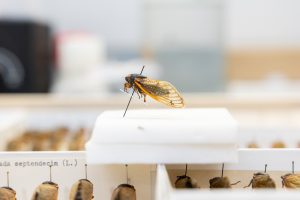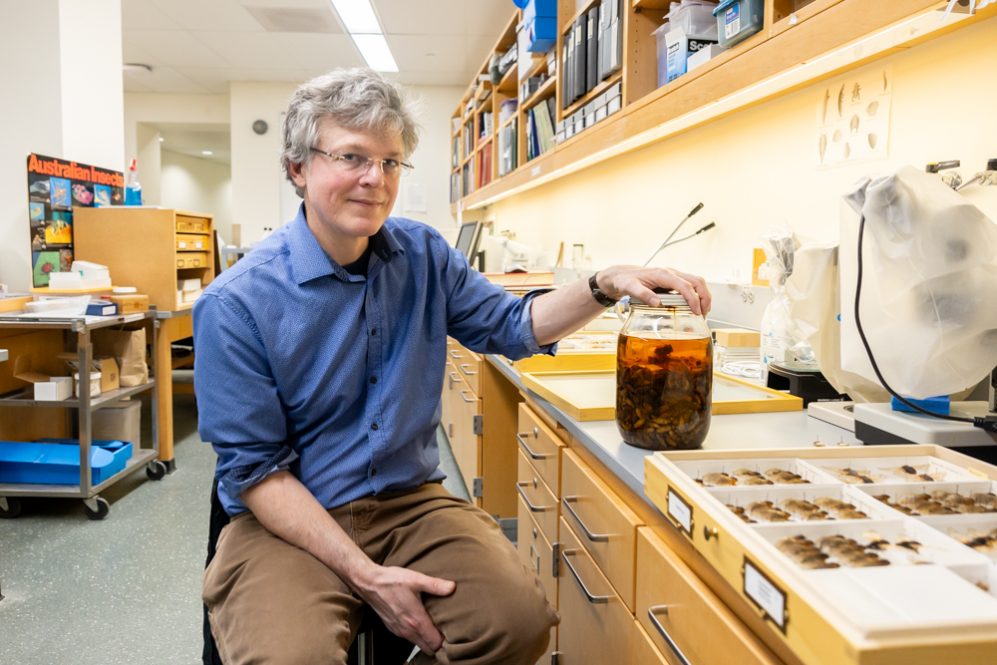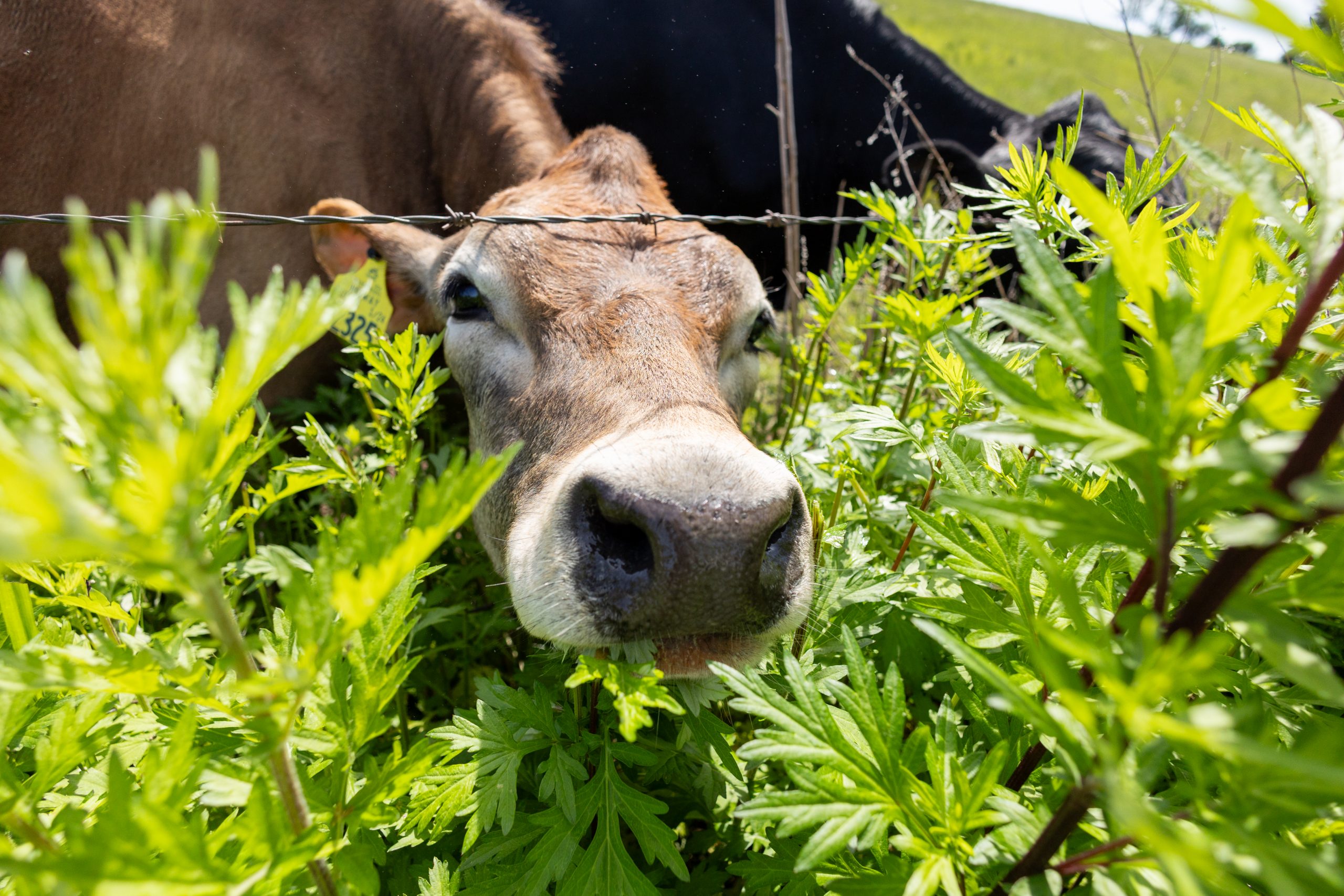For those lucky enough to have had the experience, a periodical cicada emergence is like nothing else. The harmless insects emerge in the late spring or early summer en masse and sing in an almost deafening chorus. The spectacle is brief and if conditions are favorable, the brood may emerge again — in 13 or 17 years, depending on their schedule.
Researchers from UConn have long studied periodical cicadas, including a 17-year brood that once resided along the Fenton River in UConn’s backyard who sang their last chorus in 1954. Though they couldn’t have known at the time, the researchers’ observations would be crucial because they documented the brood and their last appearances, but through the years some of that data has been shuffled around or forgotten. This is a story of re-discovery and compiling vital data to understand the past, present, and future of periodical cicadas.
UConn Ecology and Evolutionary Biology Professor Chris Simon and Associate Professor-in-Residence John Cooley are some of the world’s leading experts in periodical cicadas, so it’s not surprising that Simon came across photo negatives of a cicada emergence that someone dropped by.
“We found them when we were organizing my lab, and I don’t know who gave them to us but whoever did must have figured that we would want them,” says Simon.
That “someone” was right, because Simon and Cooley quickly realized the photos were taken by former UConn faculty member and prolific unofficial UConn photographer Jerauld A. Manter in 1937, during Brood XI’s second-to-last emergence. The photos represent a rediscovered part of UConn history and are now safely at home in the UConn Archives and Special Collections, but they also help answer some questions about the now-extinct brood.
The timing could not have been better, because 2024 brings a spectacular emergence of 13-year Brood XIX cicadas and 17-year Brood XIII, the first time these broods have co-emerged since 1803. Unfortunately, Connecticut will not get to experience the action this year, but areas of Illinois and other midwestern states, some southeastern states, and as far north as Maryland are in for an exciting cicada season.
Simon and Cooley have been busy communicating about the upcoming emergence, as has been the case with previous years, but this one is a little different, says Cooley. “This time around there are more questions about the climate change angle and how it will impact periodical cicadas. This story with the Manter negatives is more than minimally tangential to that question and that’s why it is interesting that these recently surfaced.”
Periodical cicadas, with their 13 and 17-year life cycles, are unusual among insects. The long periods between emergences also make them tricky to study, since a researcher may only get a few chances to see a particular brood emerge within their lifetime, so getting as much well-documented data as possible is important for studying and understanding these insects. Plus, as we saw with Brood XI, broods can fluctuate or disappear for various reasons.

Simon explains that the story of why Connecticut’s Brood XI disappeared after 1954 is a little mysterious, since current climate and forest conditions in the northeast are ideal for cicadas compared to 200 years ago when most of New England’s forests were cleared.
“I think that the extensive clearing of New England’s forests knocked them back because they were a small brood to begin with and when you see old pictures you see the rolling hills with no trees, just hedgerows and fences,” Simon says.
Despite having the right climate and forests now, Cooley and Simon also think Brood XI’s absence could be due to the cicada’s unusual biology. Additionally, Brood XI was a fringe population, and they may have been pushed beyond a critical threshold despite the improvement in conditions.
“Maybe their numbers were not dense enough,” says Cooley. “They persisted like they do on edges and in our riparian woods, but at low enough densities, they could have just got pinched off.”
Cooley says the rediscovered photos can help answer some lingering questions about Brood XI.
“Manter’s photos confirm there was only one species present in this brood, which is not unusual for edge broods or edges of the general distribution,” Cooley says. “They’re another piece of data about this brood, which is helpful because back then, they didn’t label everything carefully. They are the only other things that exist besides notes and papers that were published and some pinned specimens floating around in various collections.”
Some of the other specimens left from this lost brood are literally floating around, contained in a massive glass jar that a former professor once told Cooley about. The unlabeled jar eventually surfaced and since there can’t be too many industrial-sized mayonnaise jars full of cicadas milling around, Cooley says he reasoned they must be Brood XI.
“I was told an entomology class went out in 1954 and filled a big jar full of cicadas and preservatives, so they would have insects to dissect in the lab, but that never happened. It’s the last collection of this brood and now having the photographs to back it up is helpful because the problem is the specimens in the jar were collected at the beginning of the emergence and they don’t have a typical appearance, they tend to be very yellow, and they look weird. Manter’s photographs show us a much more typical appearance of adult cicadas, [though] you can never rule out any questions that they had a bit of an odd appearance to them. We connected the dots and the photographs helped close another gap in that story.”
Since 1954, researchers have gone out every 17 years in hopes of spotting Brood XI, in case they aren’t extinct.
“In 2005 we published a paper on the brood, and I wanted the subtitle of the paper to be ‘It’s still dead’ because they’re still gone and we searched up and down,” says Cooley.
Cooley went back for the most recent scheduled emergence, two years ago, still with no luck.
Though it is sad knowing the cicadas in the photos and those preserved in the mayonnaise jar were among the last of their brood, Cooley says it is important to put it into perspective.
“Brood XI, even in its heyday was an edge population and when you have climate or habitat fluctuations that cause local extinctions, edge populations are especially sensitive because that’s marginal habitat anyway. We’ve seen other populations blink on and off around the edges. That’s not in and of itself, particularly remarkable.”
A big question now is how climate change will impact the rest of the population of periodical cicadas. Cooley says the real heart of the story is time lags. For instance, even if carbon emissions are stopped right now, there are already processes in motion that cannot be stopped. Couple this with an unusually long lifecycle like 13 and 17-year cicadas, and things can get tricky to anticipate.
“The die may be cast, and the cicadas still could be in trouble. That’s a good model for how a lot of climate change works: even if you stopped all the things that are changing the climate, it’s not going just fix itself immediately.”
Simon says populations can also fluctuate greatly from generation to generation in some locations in unexpected ways:
“They can fluctuate up and down. For instance, in 1997, Cooley revisited one location where the heaviest Magicicada emergence ever recorded was censused in 1956, and he found zero cicadas, even though other populations were still present farther away.”

Cooley and Simon say the cicada researchers all have anecdotes along these lines and that just emphasizes the importance of gathering as much data as we can, while we can, because a brood may not emerge as expected especially with potential additional surprises brought by the changing climate.
“The yearly amount of growth of periodical cicadas is tied to growing season length,” says Simon. “So, as the climate warms, the growing season is going to be longer in any particular place. That’s why it’s so important to document everything historically so in the future, people can figure out what’s going on.”
Citizen scientists can help the researchers track emergences with an app called Cicada Safari. Thanks to the app and citizen scientists, the researchers can map points of interest, which can include details like temperature, photos, and other information to document conditions for the cicada emergence. With each new generation, new technologies help with this research, says Simon, who, as a grad student, would start the season mailing out postcards to county agents in each county where the cicadas were set to emerge. Now with the app, researchers can get a real-time look at what is happening and identify potential points of interest because the researchers cannot be everywhere all at once. Most importantly, the data is labeled, making it less likely to be lost in time.
So, how will climate change impact periodical cicada populations?
“I don’t know, check back,” says Cooley. “I’m not going to be around to see if there’s a problem. That is a downside of periodical cicada work. You don’t get much more than a tiny glimpse at the longitudinal aspect of this whole thing.”



